Beekeeping has long been recognised as a sustainable activity, providing vital support to ecosystems while offering numerous personal rewards. For those living off-grid, it’s a natural extension of self-sufficient living. Beekeeping aligns seamlessly with an off-grid lifestyle, requiring minimal external resources and offering numerous benefits in return.
The positive ecological impacts of keeping bees are extensive. Bees are essential pollinators, ensuring the growth of crops, wildflowers, and trees that sustain both human and animal life. Beyond their environmental contributions, beekeeping also provides beneficial products like honey, wax, and propolis. These can be used personally, shared locally, or sold to generate income, offering both sustenance and a means to diversify off-grid earnings.
Explore the key aspects of off-grid beekeeping, from selecting the right hive and bee species to understanding their role in the local ecosystem. With the right knowledge and preparation, you can enjoy the many rewards of this enriching pursuit.
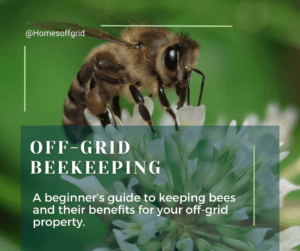
Bee Care and Welfare
Ensuring the well-being of your bees is essential for a thriving and sustainable apiary. Proper care and welfare practices not only safeguard your colonies but also support their productivity and the broader ecosystem.
For beginners, it’s advisable to start with one or two hives. This number allows you to gain experience and manage your colonies effectively without becoming overwhelmed. As you become more confident in your beekeeping skills, you can consider expanding your apiary.
Housing and Hive Placement
The placement and design of your hives significantly impact the health and comfort of your bees. It is important to choose the right location based on sunlight, wind and accessibility. Position your hives where they receive ample morning sunlight to encourage early foraging. Shelter them from strong winds and avoid low-lying areas prone to dampness. Ensure the site is accessible for regular checks while maintaining a safe distance from busy areas, reducing stress for both you and the bees.
A reasonably sized site of at least half an acre is recommended to provide sufficient forage and reduce the risk of bees becoming a nuisance to neighbours.
Feeding and Seasonal Care
While bees are largely self-sufficient, certain times of the year may require additional support. During periods when nectar and pollen are scarce, such as winter or prolonged dry periods, you may need to supplement your bees’ diet with sugar syrup or fondant. However, you should ensure feeding is done responsibly to avoid over-dependence or contamination of natural resources.
In late spring and summer, hives should be inspected weekly to provide more space for honey storage and to monitor for swarming. Swarming is a natural part of a bee colony’s reproductive cycle, typically occurring in late spring or early summer. When a colony becomes too crowded or the queen ages, the bees prepare to divide. The queen and roughly half the worker bees leave the hive to establish a new colony elsewhere, leaving behind a developing new queen to take over the original hive. While swarming is a natural process, it can reduce the productivity of your colony, as fewer bees remain to collect nectar and tend to the hive. Regular inspections during the active seasons can help you spot early signs of swarming, such as the development of queen cells (special brood cells where new queens are raised). By providing additional space for honey storage or taking other management steps, you can reduce the likelihood of swarming and maintain a thriving hive.
During winter, occasional checks are sufficient to ensure hives have not been disturbed and that bees have adequate food stores.
Monitoring Health
Proactive health management is critical for preventing issues that could decimate your colonies. It is important to regularly inspect your hives for signs of common threats such as Varroa mites, foulbrood, or wax moths. Employ non-chemical control measures wherever possible, such as screened bottom boards for mite reduction, to align with sustainable practices. Maintaining clean hives and practising biosecurity helps minimise disease risks.
Minimising Human Intervention
Adopting a low-intervention approach respects the natural rhythms of your bees, reducing stress and fostering resilience. Techniques like using horizontal or top-bar hives promote less intrusive inspections. Allowing bees to build natural comb and minimising hive manipulations helps them thrive in an environment that mimics their natural habitats.
By prioritising thoughtful placement, seasonal support, health monitoring, and natural practices, you can ensure your bees remain healthy and productive. This approach not only benefits your colonies but also reflects the values of self-sufficiency and ecological stewardship central to off-grid living.
Types of Beehives
Choosing the right type of beehive is a crucial step in starting your off-grid beekeeping journey. The hive you select will influence how you manage your bees, the resources required, and how well it fits with your off-grid lifestyle. Your hive choice may also be influenced by the type of bee you choose to keep.
Traditional Hives
National Standard Hives: The National Standard Hive is the most commonly used beehive in the UK. Its design includes modular components with removable frames, making it easy to manage and maintain. This hive is particularly popular with hobbyist and commercial beekeepers alike. These hives are widely available, straightforward to use, and compatible with many beekeeping tools and accessories. The modular design allows for easy expansion and honey extraction. They require frequent checks and maintenance, which may not suit those looking for minimal intervention.
Langstroth Hives: One of the most widely used designs, the Langstroth hive features a series of stacked, removable frames. This modular structure simplifies honey extraction and colony management, making it ideal for beginners. These hives are easy to expand, efficient for honey production, and compatible with many beekeeping tools. They require more frequent intervention and maintenance, which may not align with low-intervention off-grid practices.
Warre Hives
Developed as a “bee-centric” design, Warre hives consist of vertical boxes with fixed combs, encouraging a more natural bee environment. They require less maintenance, promotes natural behaviours, and requires fewer resources to construct. However, honey extraction can be more labour-intensive due to the fixed combs.
Top-Bar Hives
Known for their simplicity, top-bar hives use horizontal bars for bees to build combs. This design prioritises ease of access and minimal intervention. They are cost-effective, easy to build, and suitable for natural beekeeping methods. They produce less honey compared to Langstroth hives and are less suited for commercial beekeeping.
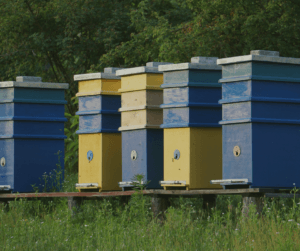
Natural or Alternative Hives
Log Hives and Skeps: These traditional hive styles mimic natural nesting sites, such as hollow logs. While less common today, they offer a minimalist approach to beekeeping. These hives promote natural behaviours and require minimal construction. However, there is limited access for management, making them better suited to experienced beekeepers or as habitat support for wild bees.
Horizontal Hives: Similar to top-bar hives but with greater capacity, horizontal hives offer a balance between natural and managed beekeeping. Minimal intervention is required and they are well-suited for off-grid environments where simplicity is key. Larger footprint may be unsuitable for compact spaces.
Suitability for Off-Grid Settings
For off-grid beekeeping, the best hive will depend on your priorities, available resources, and beekeeping philosophy. Warre and top-bar hives are excellent choices for those seeking low-maintenance options that align with natural practices. However, if honey production is a primary goal, a National or Langstroth hive might be the better option despite their greater resource needs. By selecting a hive that matches your goals and environment, you can establish a thriving beekeeping operation while staying true to the principles of off-grid living.
Choosing the Right Bees For You
The type of bees you choose to keep can greatly influence the success of your off-grid apiary. Understanding the characteristics of different species and subspecies will help you select bees that suit your goals and local environment.
Common Honeybee Species
Apis mellifera (European Honeybee)
The European honeybee is the most widely kept species for beekeeping, valued for its adaptability and productivity. Within this species, there are several subspecies, each with unique traits:
- Apis mellifera ligustica (Italian Bee): Known for its gentle temperament, high honey production, and strong brood-rearing capabilities. Ideal for beginners but may consume more stores in winter.
- Apis mellifera mellifera (Dark European Bee or Black Bee): A hardy subspecies adapted to cooler climates but may display more defensive behaviour compared to others.
- Apis mellifera carnica (Carniolan Bee): Favoured for its resistance to cold weather, calm nature, and efficient use of resources. Well-suited for temperate climates.
When choosing a honeybee species, consider your local climate and your desired level of colony management. You may find a hybrid to be the best option.
Ethical Sourcing of Bees
How you source your bees plays a crucial role in promoting sustainability and protecting biodiversity.
- Buying Locally: Purchase bees from certified breeders within your area to reduce transportation stress and ensure compatibility with the local environment. Native or locally adapted species are better suited to the climate and ecosystem, enhancing colony resilience.
- Supporting Sustainable Practices: Seek out organisations dedicated to rearing native bees or preserving species diversity. Your support helps these groups continue their vital work in environmental conservation.
- Capturing Swarms: If you have the proper training and permissions, capturing swarms offers a natural way to start or expand your apiary. When done correctly it’s an eco-friendly option that supports colony survival.
- Avoiding Unethical Sources: Steer clear of mass-bred bees from suppliers with poor welfare standards. These practices risk spreading diseases, genetic dilution, and ecological imbalance.
Beekeeping and the Local Ecosystem
Establishing an off-grid apiary goes beyond caring for your bees – it also involves understanding and supporting the surrounding ecosystem. The presence of a beehive can create a ripple effect, influencing local flora and fauna in both positive and challenging ways.
Interactions with Existing Flora and Fauna
The success of your apiary is closely tied to the availability of diverse, high-quality forage. Bees rely on a variety of plants for nectar and pollen, which directly affect their health and honey production. Likewise, bees play a crucial role in pollinating flowering plants, helping to ensure the reproduction of crops, wildflowers, and trees. This pollination benefits the entire ecosystem, promoting biodiversity and supporting wildlife that depends on plants for food and shelter.
You can enhance your apiary’s success and ecological contribution by cultivating plants that provide consistent forage throughout the seasons. Consider planting early-blooming flowers like crocuses or dandelions to sustain bees emerging from winter. Wildflowers such as clover, lavender, or foxgloves, are also beneficial as they are rich in nectar. Meanwhile, native trees like willow or lime provide abundant resources for bees and other pollinators. Focusing on native vegetation ensures that your efforts align with local ecosystems, creating a supportive environment for your bees and other wildlife.
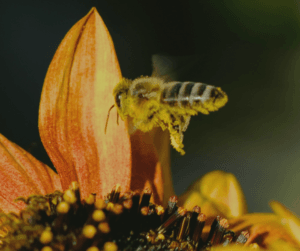
Ecological Competition
Introducing honeybees to an area requires careful consideration of their impact on native pollinator species. High densities of honeybees can strain local ecosystems, reducing the availability of nectar and pollen for native bees, butterflies, and other insects. This competition may lead to declines in populations of less dominant species.
To minimise ecological disruption, avoid overstocking hives in one location. Monitor the availability of forage and consider rotating hives to prevent resource depletion. Additionally, planting a variety of bee-friendly plants can mitigate competition by expanding the resource pool.
Choosing Native Vs Non-Native Bees
For off-grid beekeeping, native bee species can offer significant ecological benefits. These bees are naturally adapted to the local environment, making them resilient to regional pests and diseases. Additionally, they often have lower resource needs and pose less risk to wild pollinators. Using native species can support local biodiversity by enhancing pollination of indigenous plants and crops. While native bees may not produce as much honey as European honeybees, their contribution to the ecosystem makes them a valuable choice for sustainable beekeeping practices.
Meanwhile, introducing non-native bees to an area can create ecological risks. Non-native bees may hybridise with local species, potentially diluting genetic traits that are vital for survival in the region. They can also compete with wild pollinators for food and nesting resources, which can harm native populations, causing potentially more damage than a new colony of native bees. Bees imported from other regions may even carry pests or diseases that can spread to local colonies, jeopardising their health and the surrounding ecosystem.
Dealing with Invasive Species
Invasive species pose significant threats to beekeeping and local ecosystems. Vigilance and proactive management are key to protecting your apiary.
Asian hornets prey on honeybees, targeting foragers and colonies. You may need to consider building hornet traps or monitoring their presence can help control infestations. Meanwhile, varroa mites are another common issue, weakening colonies by feeding on bees and transmitting viruses. Regular hive inspections and natural treatments, like powdered sugar dusting, can reduce mite populations.
Collaboration with local authorities and beekeeping associations can help you stay informed about invasive species in your area. Early detection and intervention are crucial to minimising their impact on your bees and the surrounding environment.
By fostering a balance between your apiary and its ecosystem, you can create a sustainable, harmonious setup that supports both your bees and the local environment.
Benefits of Beekeeping
Beekeeping offers numerous benefits, making it a valuable addition to any off-grid lifestyle. From enhancing the health of your land to providing personal rewards and business opportunities, the impact of maintaining an apiary extends well beyond the hive itself.
For Your Land
A thriving bee colony can transform your land, boosting both its productivity and ecological health.
- Improved Pollination Leading to Better Crop Yields and Biodiversity: Bees are vital pollinators, playing a central role in the reproduction of flowering plants. With a nearby hive, your fruit trees, vegetables, and flowering crops will benefit from higher pollination rates, leading to improved yields. This natural process also encourages biodiversity by supporting wild plants and the animals that depend on them.
- Enhanced Soil Health Through Plant Diversity: Increased pollination promotes the growth of a wider range of plants, which can improve soil structure and fertility. Diverse vegetation helps to prevent soil erosion, promotes nutrient cycling, and fosters a resilient ecosystem on your land.
For Yourself
Beekeeping provides useful products and personal enrichment, making it a deeply rewarding activity for off-grid homesteaders.
- Honey Production, Wax, and Other Bee Products for Personal Use: Harvesting honey, wax, and propolis from your hives offers a renewable source of natural goods. Honey can serve as a sweetener, a home remedy, or a key ingredient in cooking, while wax is perfect for candles, balms, and polishes. Propolis has antibacterial properties and can be used in tinctures or ointments.
- The Therapeutic Benefits of Working with Bees: Engaging with your bees fosters a sense of connection with nature and provides a calming, meditative experience. Observing their complex behaviours can deepen your understanding of the natural world, while the hands-on work helps to build patience and focus.
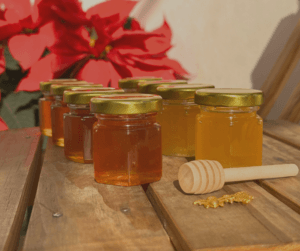
As a Business Opportunity
Beekeeping offers several income-generating possibilities that align well with the principles of off-grid living. This reduces reliance on a single form of income, contributing to greater financial stability and self-sufficiency.
- Selling Honey, Wax, and Other Products:
Bottled honey, beeswax candles, and handmade balms can be sold locally or at markets, providing a source of income. These natural, high-quality products are often in demand and can fetch a premium price, especially if marketed as sustainably produced. - Providing Learning Opportunities:
Once you have learnt the necessary skills for beekeeping you may choose to share that knowledge with others. Providing classes and teaching others is a great way to generate income on your land. - Offering Pollination Services:
In agricultural regions, beekeepers can rent out hives to farmers for pollination. This service not only benefits crops but also provides an additional income stream for your off-grid venture.
By enhancing your land, enriching your personal life, and opening doors to sustainable income opportunities, beekeeping proves to be a valuable pursuit for anyone living off-grid.
Challenges and Solutions in Off-Grid Beekeeping
While beekeeping aligns well with off-grid living, certain challenges are unique to this lifestyle. Addressing these obstacles with practical solutions ensures a successful and sustainable apiary.
Off-grid locations often lack immediate access to supplies and specialised equipment. Therefore, it’s important to plan ahead by stocking essential tools like hive tools, protective gear, and feeding supplies. Build relationships with local or regional beekeeping suppliers to reduce delivery delays and costs. Where possible, craft your own equipment or repurpose materials to suit your needs, enhancing self-reliance.
You may also face power problems in an off-grid setting. Honey extraction, hive monitoring, and processing honey for storage can demand energy inputs. You should opt for manual tools as much as possible, such as hand-cranked honey extractors, which eliminate the need for electricity. Solar-powered tools, like wax melters or monitoring systems, offer sustainable energy solutions. Simplify honey processing techniques to minimise energy demands while maintaining product quality.
Environmental extremes can lead to other challenges in beekeeping. Off-grid locations may experience harsher environmental conditions, such as prolonged droughts or severe winters, which can strain colonies. You should enhance hive insulation to protect bees from extreme cold and keep hives elevated or shaded to avoid overheating during summer. Provide supplemental feeding during resource-scarce periods to support colony survival. Selecting locally adapted bee species can also improve resilience to regional climate challenges.
By recognising and preparing for these challenges, you can adapt your beekeeping practices to thrive in an off-grid environment. These solutions not only overcome obstacles but also reinforce the self-sufficient ethos that defines off-grid living.
Learning More
Embarking on your beekeeping journey requires a basis level of knowledge prior to purchasing anything. The world of beekeeping is rich with resources to guide you, whether you’re a beginner or looking to refine your skills.
- Recommended Books: Books such as The Beekeeper’s Bible offer a comprehensive foundation, covering history, practical tips, and advanced techniques. Similarly, Beekeeping for Dummies provides accessible insights and clear guidance for novice beekeepers.
- Online Courses: Organisations like the British Beekeepers Association (BBKA) offer structured online courses suitable for all skill levels. These cover topics ranging from basic hive management to advanced techniques for maximising colony health and productivity. Local associations often run similar courses, making them valuable regional resources.
- Community Groups: Joining local or regional beekeeping clubs connects you with experienced mentors and provides a platform for sharing ideas, troubleshooting, and staying updated on beekeeping trends.
By studying reliable educational resources, you lay the groundwork for responsible and rewarding beekeeping. These preparations not only benefit your colonies but also contributes to broader ecological health and sustainability.
Conclusion
Off-grid beekeeping offers a unique and fulfilling way to integrate nature into your self-sufficient lifestyle. The rewards are numerous: from enhancing your land’s biodiversity and improving crop yields through pollination, to the personal satisfaction of producing honey, wax, and other valuable products. Beekeeping also offers the potential for diversifying your off-grid income, making it not only a sustainable practice but also a rewarding business opportunity.
However, like any off-grid endeavour, beekeeping comes with its challenges. Limited access to resources, managing energy needs for extraction and processing, and coping with environmental extremes such as drought or harsh winters can test your resilience and creativity. By understanding these challenges and implementing practical solutions, you can ensure the long-term success of your apiary.
Beekeeping aligns perfectly with the values of self-sufficiency and sustainability. It allows you to live in harmony with the natural world, while providing practical and ecological benefits that extend beyond your apiary. Whether you’re starting with a few hives or looking to expand, the practice of beekeeping can be a valuable addition to your off-grid lifestyle.
Explore the world of beekeeping and discover how it can enhance both your off-grid experience and the environment around you.
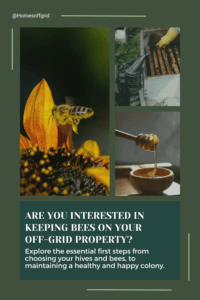
To find out more about off-grid living return to our Reading Room.
Disclosure: This post contains affiliate links. This means we receive a commission if you decide to purchase through our links, at no extra cost to you. We will only recommend products that we use and trust. The majority of links are for Amazon, most books are available elsewhere but Amazon provides reviews and helpful descriptions.


